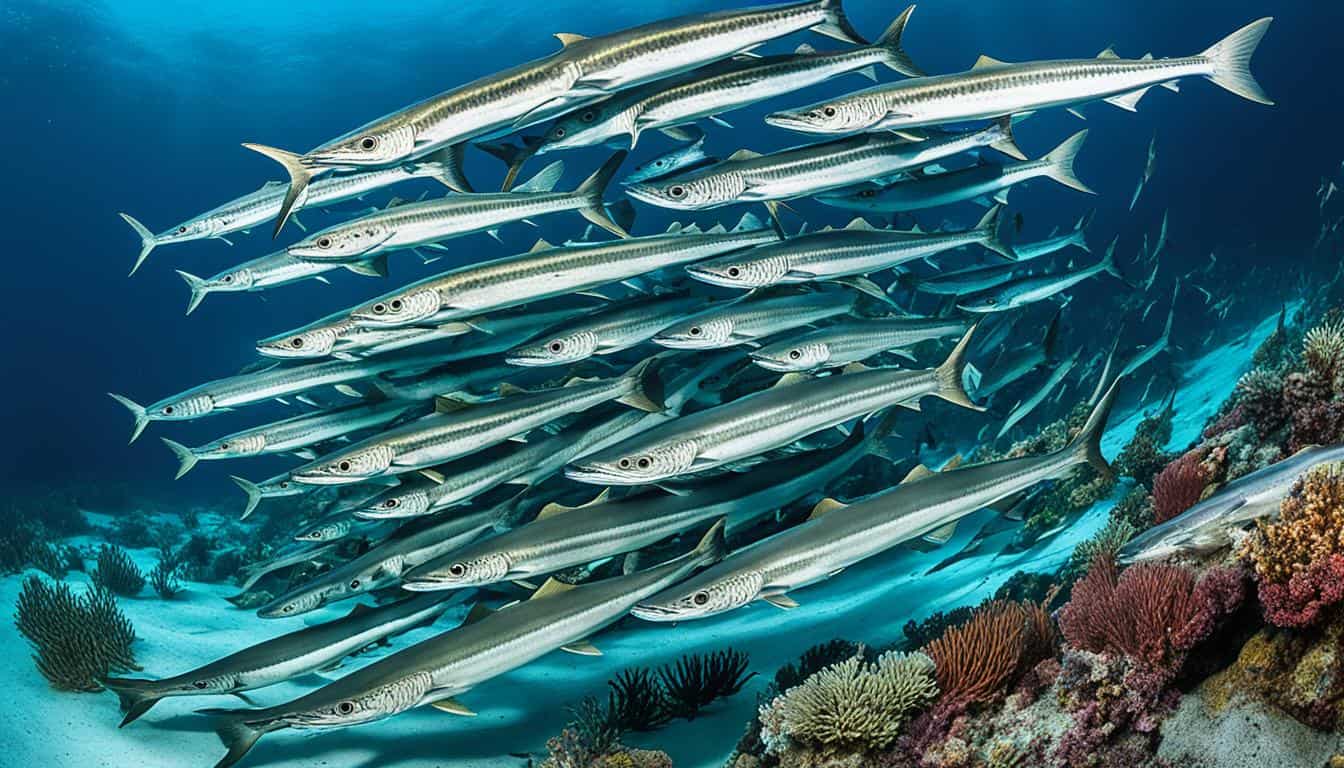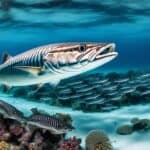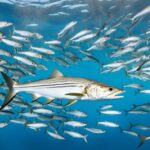Barracudas are big predatory fish in the Sphyraena genus. They are known for their scary look. You might ask: what kinds of barracudas are there? These fish live in warm and tropical waters, like the Atlantic Ocean, Caribbean Sea, and Pacific Ocean. They have long bodies and sharp teeth, making them great hunters in the ocean.
This article will cover the different types of barracudas. You’ll learn about their classification, unique traits, how they act, their relationship with humans, and their conservation status. You’ll see how these fish play a big part in the ocean’s ecosystem.
Understanding Barracuda Classification
Classifying barracudas helps us understand their biology and evolution. They belong to the family Sphyraenidae, known for its carnivorous fish. The genus Sphyraena, created by Constantine Samuel Rafinesque in 1815, includes many species. The Great Barracuda (Sphyraena barracuda) is one of the most well-known.
Family and Genus Overview
The Sphyraenidae family is home to fast, predatory fish with long bodies and sharp teeth. The genus Sphyraena has several species, each with its own unique features. Knowing how to classify barracudas helps us understand their survival skills and where they fit in nature.
Taxonomic Hierarchy
Barracudas are classified within a larger biological framework. They fall under the domain Eukaryota, phylum Chordata, and order Istiophoriformes, showing they are ray-finned fish. This classification helps scientists and sea lovers identify and study different species.
What are the different species of barracudas?
The world of barracudas is full of variety, with many kinds that fascinate both scientists and those who love fishing. There are 29 recognized species of barracudas, each with its own unique traits and places it calls home. Learning about these species can deepen your understanding and appreciation of these fascinating fish.
Leading Species Varieties
Some notable barracuda species include:
- Great Barracuda (Sphyraena barracuda): Known for its large size and fierce hunting skills.
- Pacific Barracuda (Sphyraena argentea): Famous for its speed and presence in warm waters.
- Pickhandle Barracuda (Sphyraena jello): Identified by its long shape and unique colors.
- Southern Sennet (Sphyraena picudilla): Known for its swift swimming and special body pattern.
Identification of Key Species
To identify different barracuda species, pay attention to their unique traits:
| Species | Size (Feet) | Habitat | Notable Features |
|---|---|---|---|
| Great Barracuda | 6 – 10 | Tropical and subtropical waters | Aggressive predator, sharp teeth |
| Pacific Barracuda | 3 – 4.5 | Coastal regions | Silver body with dark stripes |
| Pickhandle Barracuda | 2 – 3 | Shallow reefs | Pale body with dark markings |
| Southern Sennet | 2 – 3.5 | Coastal waters | Broad dorsal fin |
Unique Features of Barracuda Species
Barracudas are fascinating creatures with unique traits and diverse habitats. These features make them stand out and play important roles in marine ecosystems.
Physical Characteristics
Barracudas have elongated, streamlined bodies that help them move quickly through the water. Their pointed snouts and sharp teeth make them great hunters. They often have:
- Dark gray or blue on the upper body
- Silver sides
- White belly with potential dark spots or transverse bars
These features help them hunt and blend in with their surroundings, which is key to their survival.
Habitat and Distribution
Barracudas live in tropical and subtropical waters, in places like:
- Coral reefs
- Mangroves
- Seagrass beds
Juveniles like to stay in safe spots, while adults move into open waters. This shows how adaptable they are.
| Feature | Details |
|---|---|
| Body Shape | Streamlined for fast swimming |
| Teeth | Multiple sharp rows for catching prey |
| Coloration | Dark gray/blue upper body, silver sides, white belly |
| Juvenile Habitat | Prefer sheltered areas |
| Adult Habitat | Open waters |
Behavior and Diet of Barracuda Species
Barracudas are fascinating creatures known for their exceptional hunting skills and distinct feeding behaviors. As you explore the types of barracudas, you’ll discover that these fish employ various predatory strategies to secure their meals effectively.
Predatory Strategies
Barracudas are celebrated for their ambush hunting tactics. With their incredible swimming speed, which can reach up to 35 mph, they catch prey off guard. This agility enables them to make swift maneuvers while stalking smaller fish like jacks and grunts. They often hunt alone or in small groups, enhancing their effectiveness as predators.
Feeding Habits
The barracuda diet is quite diverse, primarily consisting of smaller fish. Their opportunistic nature allows them to consume prey that may even surpass their size. Utilizing their keen eyesight, they can track movements in the water, ensuring they don’t miss capturing a meal. This combination of speed, strategy, and sharp vision underscores their position as formidable hunters in their marine habitats.

Interactions Between Barracuda Species and Humans
The relationship between barracuda and humans is both exciting and requires caution. Fishing for barracuda can be thrilling for those who love adventure. These fish are known for their strength and agility, making fishing for them a unique experience.
However, it’s important to know how to stay safe when interacting with barracuda. This is because there can be occasional encounters with humans.
Fishing and Sport
Barracuda fishing is a favorite activity for many sport fishers. The Great Barracuda is especially sought after for its strong fight. Anglers find the challenge of catching these fast and strong fish exciting.
Reeling in a barracuda can lead to unforgettable moments on the water.
Safety Precautions
Even though barracuda attacks on humans are rare, it’s important to know how they behave. They often approach out of curiosity or mistake shiny things for food. So, it’s crucial to be careful while swimming or fishing where barracuda live.
It’s also important to handle and prepare barracuda safely. Eating contaminated fish can lead to ciguatera poisoning. Being aware and cautious helps ensure safe and fun experiences with barracuda.
Conservation Status of Barracuda Species
The current status of barracuda species is not endangered or vulnerable, according to the International Union for Conservation of Nature (IUCN). But, they face threats from overfishing and habitat destruction. These threats put their populations and ecosystems at risk, making conservation urgent.
It’s key to use sustainable fishing practices to protect barracudas. Following rules and supporting responsible fishing helps these predators thrive. Also, saving their habitats is crucial to help them survive.
Keeping an eye on barracuda populations and their homes is important. This helps us know how to protect them better. With your help and awareness, we can keep these amazing fish around for the future.
FAQ
What are the most recognized species of barracudas?
The Great Barracuda (Sphyraena barracuda) and the Pacific Barracuda (Sphyraena argentea) are well-known. Other species include the Pickhandle Barracuda (Sphyraena jello) and the Southern Sennet (Sphyraena picudilla).
How are barracudas classified?
Barracudas are part of the family Sphyraenidae and the genus Sphyraena. They fall under the domain Eukaryota and the phylum Chordata. They are classified as ray-finned fish in the order Istiophoriformes.
Are there different kinds of barracudas based on their habitat?
Yes, barracudas live in various places, like near coral reefs, mangroves, and seagrass beds. Young ones like safe spots, while adults prefer open waters.
What unique features do barracudas have?
Barracudas have long, sleek bodies, sharp snouts, and teeth. They often have dark gray or blue tops, silver sides, and spots or bars.
What are the primary dietary habits of barracuda species?
Barracudas eat smaller fish like jacks and grunts. They use their speed, up to 35 mph, to surprise their prey.
How do humans interact with barracudas?
People enjoy fishing for barracudas because they are challenging. But, it’s important to be careful since barracudas rarely attack humans. This happens when they are curious or mistake a person for food.
What is the conservation status of barracuda species?
Barracudas are not endangered or vulnerable yet. But, they face threats from overfishing and losing their homes. It’s important to fish sustainably and protect their habitats.







